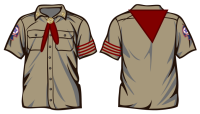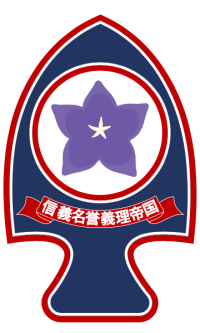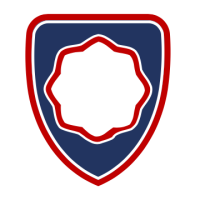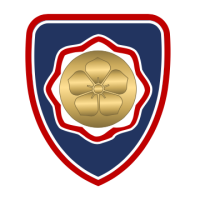Sidebar
Table of Contents
Kikyō Scouts
The Kikyō Scouts are the youth organization of the Yamatai Star Empire, as an outreach of the Star Army of Yamatai. They aim to teach citizenship, leadership, and Paramilitary Scouting skills.
| Creed | Fidelity, Honor, Duty, Empire Yamataigo (邪馬台語): 信義名誉義理名誉 (Shingi, Meiyo, Giri, Teikoku) |
|---|---|
| Mission | To build courage, confidence, and character to prepare the next generation of Yamataians to be the leaders of the future! |
History
In YE 33, a year after the founding of the Star Army Rikugun, that organization realized it needed to find a way to train civilian youth in the skills they needed among the populace to increase the fitness of the recruiting pool for planetside infantry. Additionally, to instill love for Empress and Empire in an educated, participatory population of good character, even in those who do not choose to serve, or serve in other capacities.
Organization
The Kikyō Scouts are organized only at the local and central levels. There is no bureaucracy between local organizations, known as Troops, and the central authority, the Grand Council.
Troops
Troops are organized at the local level, by application to the Grand Council by a qualified adult leader. When there are more Scouts than easily manageable, a new Troop is formed if a new leader is available, and they will be split as evenly as possible. There are no age, gender, or species divisions within a Troop, although Scouts are ranked by academic grade level. A troop is referred to by its locality, its its troop number, and finally by its mascot, in that order: for example, the “Tsubomi Troop 110 'Bobcats'.”
Adult Leaders
Adult leaders for troops are generally drawn from the ranks of former Star Army of Yamatai, in particularly those from the Star Army Rikugun. Adult leaders must have spotless records and outstanding service, and experience as an educator is highly preferred, as is prior experience as a Scout. Leaders are trained in a remote course, and must pass a certification test, both offered by the Grand Council.
Grand Council
The Grand Council is based at Tsubomi, Yamatai (Planet). They are responsible for the day to day administration of the organization as a whole, certifying adult leaders, promoting scouts to Kikyō rank, and deciding and enforcing the standards of the Kikyō Scouts. The Chief and Deputy Chief of Rikugun General Staff are nominally also the top two officers of the Kikyō Scouts Grand Council.
Activities
Other than the yearly cookie sale, and all of the camping, outdoor adventure, and wilderness craft, the next activity that the average Yamataian citizen popularly associates with the Kikyō Scouts is community service. Cleaning up litter, helping elderly Humans cross the hover-lane, and generally doing prosocial good deeds all around. Additionally, the Kikyō Scouts participate in, and sponsor, many academic extracurriculars such as the Model International Relations Conference and various STEM initiatives. They also host and sponsor team and individual sports, music and art programs, and Yamataian cultural studies.
Kikyō Scouts Cookies
The notorious, infamous, yearly ritual of Kikyō Scout Cookies going on sale, in shopping centers, office buildings, street corners, and door to door in residential neighborhoods, is one of the most looked-forward to events of the year. Each year, from 2月 to 3月, the Kikyō Scouts make available their beloved, iconic baked goods.
Varieties
Available varieties vary somewhat year by year, but some core offerings always make an appearance.
- Kikyōs (Shortbread cookies in the shape of the stylized bellflowers from the Kikyō Scouts emblem)
- Lovecakes (Crumbly spiced biscuit filled with Lovefruit jam)
- Asteroids (Hollow wafers dipped in white chocolate and rolled in crushed almonds, filled with coconut paste)
- Nataria Clouds (Like Mexican wedding cookies but with nutmeg and pecans)
- Yummytais (Traditional Chocolate Chip)
Skills Taught
The Kikyō Scouts focus on teaching Yamataian youth leadership, wilderness, and paramilitary skills, as well as personal responsibility and Yamataian values.
Art and Vocations
The Kikyō Scouts have a very robust and diverse arts and crafts program, including everything from traditional Yamataian art forms, to Bushcraft.
Biology
Kikyō Scouts are capable at flora and fauna identification, to include educated guesses about an unknown species's attributes and behaviors.
Communications
The Kikyō Scouts have an active amateur radio and communications club, and stress public speaking skills.
Domestic
Kikyō Scouts learn the basics of home economics and personal finance.
Entertainment
The Kikyō Scouts participate in skits and campfire sing-alongs when at camp.
Fighting
In addition to archery, Kikyō scouts practice marksmanship (but not combat) with the Type 33/C NSP – Civilian, the General Service Pistol, Type 28, and the Origin Model 16– under strict adult supervision in tightly controlled conditions, of course. They also encourage participation in various traditional and modern Martial Arts and combat sports, sponsoring various competition teams.
Leadership
The Kikyō Scouts place heavy emphasis on becoming capable and humble leaders who lead by example, and encourage education in civics and government. Notably, the Kikyō Scouts sponsors the Model International Relations Conference.
Physical
Kikyō Scouts spend a lot of time hiking, climbing, and swimming, and have competitive teams for all of them, as well as many different sports as played in Yamatai.
Survival and Military
This is where the Kikyō Scouts excel. They teach finding water, land navigation, shelter construction, hunting, signaling, camouflage; anything and everything wilderness and survival. Scouts learn teamwork, small-unit wilderness maneuvering, reconnaissance, and patrol. Scouts run obstacle courses, play capture the flag, and crew small vessels. The Scout experience was deliberately designed to be the perfect pre-training experience for future members of the Star Army Rikugun.
Vehicles
In addition to standardized Driver's Education and Safety programs, Kikyō Scouts old enough to have a driver's license are offered off-road driving training.
Uniforms
Kikyō Scouts wear modified versions of Star Army Uniforms.
Clothing
Clothing is based loosely on common military uniforms, using items from Star Army Uniforms.
Blouse
 A button front, two-pocket, uniform blouse in Olive Drab is the top half of the Kikyō Scouts uniform. The Kikyō Scouts patch is worn the right shoulder. On the other side, around the upper arm, are one to four stripes in Hinomaru Maroon that represent the scout's rank. Adult scout leaders have a single, thick band of Hinomaru Maroon flanked by thinner stripes of Star Army Regal Blue. Rank pins like those on the headgear are worn on the lapels. In warm weather, the sleeves are worn cuffed up to just above the elbows.
A button front, two-pocket, uniform blouse in Olive Drab is the top half of the Kikyō Scouts uniform. The Kikyō Scouts patch is worn the right shoulder. On the other side, around the upper arm, are one to four stripes in Hinomaru Maroon that represent the scout's rank. Adult scout leaders have a single, thick band of Hinomaru Maroon flanked by thinner stripes of Star Army Regal Blue. Rank pins like those on the headgear are worn on the lapels. In warm weather, the sleeves are worn cuffed up to just above the elbows.
Jacket
When in the field, a Field Jacket in Olive Green or Khaki may be worn over the blouse. It features the same patches and rank stripes as the blouse, but the rank stripes are on the lower foream, just above the cuff.
Bottoms
 Only Star Army Cargo Pants, Type 22 in Olive Drab or Nataria Green or a Star Army Skirt, Pleated, Type 35, in Nataria Green or Kikyo Scouts Tartan (when not in the field) are worn as bottoms. Tights are not worn with the skirt. The skirt is referred to among Kikyō Scouts as a “Kilt,” and is often worn by Scouts of all genders and species, especially the tartan pattern.
Only Star Army Cargo Pants, Type 22 in Olive Drab or Nataria Green or a Star Army Skirt, Pleated, Type 35, in Nataria Green or Kikyo Scouts Tartan (when not in the field) are worn as bottoms. Tights are not worn with the skirt. The skirt is referred to among Kikyō Scouts as a “Kilt,” and is often worn by Scouts of all genders and species, especially the tartan pattern.
Undergarments
Accessories
Only authorized accessories may be worn with the Kikyō scouts uniform.
Footwear
Jet black Boots, Type 21, with black boot socks, are the only authorized footwear.
Headgear
The Star Army Beret in black is headgear for scouts of all ranks except Pathfinder Scouts, while the Star Army Campaign Hat is worn by adult scout leaders. The beret has a version of the Kikyō Scouts patch as a flash, with the appropriate rank pin affixed. The campaign hat only has the rank pin. Pathfinders wear a maroon beret.
Belt
The Star Army Belt, Type 35 without the holster is worn over the blouse in most situations. The Star Army Utility Belt, Type 32A31) with a sheath for the Star Army Survival Knife, Type 40 in place of the holster is worn in the field instead.
Sash
Scouts and leaders both wear the Star Army Ceremonial Sash, Type 34, upon which is fixed their earned merit badges. It is worn from the right shoulder to the left hip.
Neckerchief
A Scarf in Hinomaru Maroon is rolled into a neckerchief and secured with a brass slide bearing the scout's rank flower or the Pathfinder Arrows if earned. Adult leaders' slides bear the same kiykō symbol as senior scouts, or the Pathfinder Arrows if they themselves earned it as Kikyō Scouts.
Knife
 A sheath for the Star Army Survival Knife, Type 40 hangs from the belt in place of the holster. The Kikyō Scouts have a version of the knife with the Yamataian Roundel instead of the Star Army Hinomaru.
A sheath for the Star Army Survival Knife, Type 40 hangs from the belt in place of the holster. The Kikyō Scouts have a version of the knife with the Yamataian Roundel instead of the Star Army Hinomaru.
Gloves
When the jacket is worn in inclement weather, black utility gloves may be worn as well.
Ranks
 While the Kikyō Scouts organization as a whole is referred to as such, only a Kikyō-ranked Scout is thusly referred to as an individual. For example, one would refer to a Scout by their rank, such as “she is a Sakura Scout,” if that was the Scout's rank.
While the Kikyō Scouts organization as a whole is referred to as such, only a Kikyō-ranked Scout is thusly referred to as an individual. For example, one would refer to a Scout by their rank, such as “she is a Sakura Scout,” if that was the Scout's rank.
- Sakura (Cherry): Minkan and Nepleslian children in Shōgakkō (Elementary School) or Nekovalkyrja less than a month old.
- Ume (Plum): Minkan and Nepleslian children in Chūgakkō (Middle School) or Nekovalkyrja older than one month, but less than two months old.
- Kiku (Chrysanthemum): Minkan and Nepleslian children in Kōtōgakkō (High School) or Nekovalkyrja older than two months.
- Kikyō (Bellflower): Senior Kikyō Scouts who have demonstrated exceptional mastery of skills, dedication to Kikyō Scout principles, and leadership among their peers. This rank is not awarded automatically, but by the Grand Council when endorsed by the Troop's leadership. Adult leaders wear this rank as well, symbolic of how a Kikyō scout attaining this rank has started to blossom out of childhood and into maturity.
- Pathfinder (Arrowhead): An additional achievement available only to Kikyō-ranked scouts, Pathfinder is an intensive program in leadership and wilderness skills above and beyond what other Kikyō Scouts experience. An invitation-only Pathfinder Camp is available to the most dedicated and distinguished Kikyō scouts to earn this highly-selective honor.
Merit Badges
Merit Badges are the same size and hexagonal shape as Star Army Reconnaissance emblems, and are worn attached to the sash. They are awarded for demonstrating various skills and competencies, as well as for specific acts of service and virtue.
Pathfinder Camp
The most accomplished Kikyō Scouts train to become Pathfinders, the month-long training taking place in various classroom, wilderness, and other practical settings. Everything the Scouts had learned before attending will be tested, re-tested, and explained in further detail, and held to the highest standards, and it culminates in a leadership capstone project before the rank is awarded.
Kikyō Scouts who complete Pathfinder are given a one-rank increase on enlistment if they join the Star Army of Yamatai, beginning at Nitô Hei rather than Santô Hei, and being paid the latter grade before completing initial training, rather than as Yontô Hei.
Standard Issue
To alleviate the burden of the cost on families, the initial issue of a Kikyō Scout is courtesy of the Star Army of Yamatai. Being the youngest, and thus fastest-growing, Sakura Scouts are given yearly uniform reissue while growing, and additional reissue are given when the Scout becomes an Ume Scout and a Kiku Scout. New sets of rank pins, stripes, and neckerchief slide are issued every time the Scout is promoted.
-
- 1 each set Kikyō Scouts Rank Pins
- 2 sets Kikyō Scouts Uniform Bottoms (2 Kikyō Scouts cargo trousers or 1 cargo trousers and 1 Kikyō Scouts Kilt)
-
- 1 set Kikyō Scouts Rank Pins
- 4 sets Kikyō Scouts Undergarments
- 2 sets Kikyō Scouts Boots
- 4 sets Kikyō Scouts Boot Socks
- 1 Kikyō Scouts Beret, black or maroon for Pathfinders (Kikyō Scouts Campaign Hat for adult leaders)
-
- 1 pair Kikyō Scouts Gloves
- 1 Kikyō Scouts Survival Knife (Only issued to Ume Scouts and older!)
- 1 Canteen, with insulated pouch and shoulder strap, Olive Drab
- 1 Kikyō Scouts Backpack, Olive Drab
- 1 Kikyō Scouts Whistle, pea-less, cylindrical, chrome, with Lanyard
- 1 Kikyō Scouts Blanket, Olive Drab
- 1 Kikyō Scouts Duffel Bag, Olive Drab
OOC Notes
Yuuki created this article on 2020/01/23 15:49. Approval Thread
Clothing artwork made from stock art purchased by Wes from Dollar Photo Club. Knife and shirt artwork edit by Yuuki from artwork edited by Wes from public domain artwork Rank pins, patches, and logos by Yuuki
Page Tools
Terms of Service - Privacy Policy



